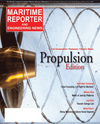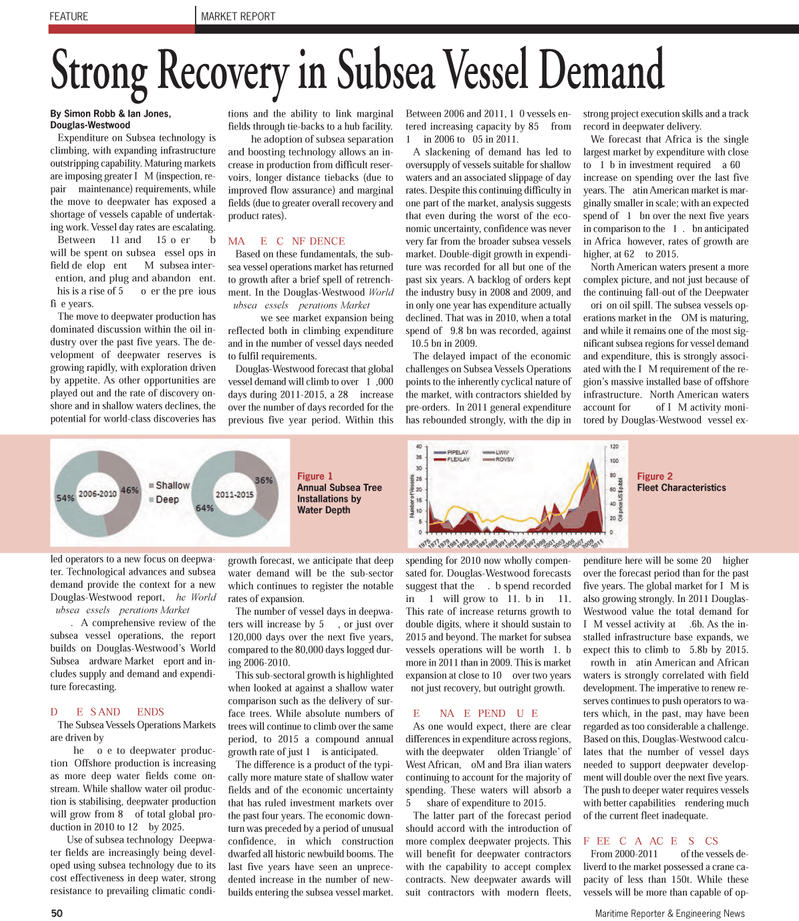
Page 50: of Maritime Reporter Magazine (September 2011)
Marine Propulsion Annual
Read this page in Pdf, Flash or Html5 edition of September 2011 Maritime Reporter Magazine
By Simon Robb & Ian Jones, Douglas-Westwood Expenditure on Subsea technology isclimbing, with expanding infrastructure outstripping capability. Maturing markets are imposing greater IM (inspection, re- pair maintenance) requirements, while the move to deepwater has exposed a shortage of vessels capable of undertak- ing work. Vessel day rates are escalating. Between 11 and 15 oer b will be spent on subsea essel ops in field deelopent M subsea inter- ention, and plug and abandonent. his is a rise of 5 oer the preious fie years. The move to deepwater production has dominated discussion within the oil in-dustry over the past five years. The de- velopment of deepwater reserves is growing rapidly, with exploration driven by appetite. As other opportunities are played out and the rate of discovery on- shore and in shallow waters declines, the potential for world-class discoveries has led operators to a new focus on deepwa- ter. Technological advances and subsea demand provide the context for a new Douglas-Westwood report, he World ubsea essels perations Market .A comprehensive review of the subsea vessel operations, the report builds on Douglas-Westwood?s World Subsea ardware Market eport and in- cludes supply and demand and expendi- ture forecasting. DES AND ENDS The Subsea Vessels Operations Markets are driven by he oe to deepwater produc- tionOffshore production is increasing as more deep water fields come on- stream. While shallow water oil produc- tion is stabilising, deepwater production will grow from 8 of total global pro- duction in 2010 to 12 by 2025. Use of subsea technology Deepwa- ter fields are increasingly being devel- oped using subsea technology due to itscost effectiveness in deep water, strong resistance to prevailing climatic condi- tions and the ability to link marginal fields through tie-backs to a hub facility. he adoption of subsea separationand boosting technologyallows an in- crease in production from difficult reser- voirs, longer distance tiebacks (due to improved flow assurance) and marginal fields (due to greater overall recovery and product rates). MAE CNFDENCE Based on these fundamentals, the sub-sea vessel operations market has returned to growth after a brief spell of retrench- ment. In the Douglas-Westwood World ubsea essels perations Market we see market expansion being reflected both in climbing expenditure and in the number of vessel days needed to fulfil requirements. Douglas-Westwood forecast that global vessel demand will climb to over 1,000 days during 2011-2015, a 28 increase over the number of days recorded for the previous five year period. Within this growth forecast, we anticipate that deep water demand will be the sub-sector which continues to register the notable rates of expansion. The number of vessel days in deepwa- ters will increase by 5, or just over 120,000 days over the next five years, compared to the 80,000 days logged dur- ing 2006-2010.This sub-sectoral growth is highlighted when looked at against a shallow water comparison such as the delivery of sur- face trees. While absolute numbers of trees will continue to climb over the same period, to 2015 a compound annualgrowth rate of just 1 is anticipated. The difference is a product of the typi- cally more mature state of shallow water fields and of the economic uncertainty that has ruled investment markets over the past four years. The economic down- turn was preceded by a period of unusual confidence, in which construction dwarfed all historic newbuild booms. The last five years have seen an unprece- dented increase in the number of new- builds entering the subsea vessel market. Between 2006 and 2011, 10 vessels en- tered increasing capacity by 85 from 1 in 2006 to 05 in 2011. A slackening of demand has led to oversupply of vessels suitable for shallow waters and an associated slippage of day rates. Despite this continuing difficulty in one part of the market, analysis suggests that even during the worst of the eco- nomic uncertainty, confidence was never very far from the broader subsea vessels market. Double-digit growth in expendi- ture was recorded for all but one of the past six years. A backlog of orders kept the industry busy in 2008 and 2009, and in only one year has expenditure actually declined. That was in 2010, when a total spend of 9.8 bn was recorded, against 10.5 bn in 2009.The delayed impact of the economicchallenges on Subsea Vessels Operations points to the inherently cyclical nature of the market, with contractors shielded by pre-orders. In 2011 general expenditure has rebounded strongly, with the dip in spending for 2010 now wholly compen- sated for. Douglas-Westwood forecasts suggest that the .b spend recorded in 1 will grow to 11.b in 11. This rate of increase returns growth to double digits, where it should sustain to2015 and beyond. The market for subsea vessels operations will be worth 1.b more in 2011 than in 2009. This is market expansion at close to 10 over two years not just recovery, but outright growth. ENA EPENDUE As one would expect, there are clear differences in expenditure across regions, with the deepwater olden Triangle? of West African, oM and Brailian waters continuing to account for the majority ofspending. These waters will absorb a 5 share of expenditure to 2015. The latter part of the forecast periodshould accord with the introduction ofmore complex deepwater projects. This will benefit for deepwater contractors with the capability to accept complex contracts. New deepwater awards will suit contractors with modern fleets,strong project execution skills and a track record in deepwater delivery. We forecast that Africa is the single largest market by expenditure with close to 1b in investment required a 60 increase on spending over the last five years. The atin American market is mar- ginally smaller in scale; with an expected spend of 1 bn over the next five years in comparison to the 1. bn anticipated in Africa however, rates of growth are higher, at 62 to 2015. North American waters present a more complex picture, and not just because of the continuing fall-out of the Deepwater orion oil spill. The subsea vessels op- erations market in the OM is maturing, and while it remains one of the most sig-nificant subsea regions for vessel demand and expenditure, this is strongly associ- ated with the IM requirement of the re- gion?s massive installed base of offshore infrastructure. North American waters account for of IM activity moni- tored by Douglas-Westwood vessel ex- penditure here will be some 20 higher over the forecast period than for the past five years. The global market for IM is also growing strongly. In 2011 Douglas- Westwood value the total demand for IM vessel activity at .6b. As the in- stalled infrastructure base expands, we expect this to climb to 5.8b by 2015. rowth in atin American and African waters is strongly correlated with field development. The imperative to renew re- serves continues to push operators to wa- ters which, in the past, may have been regarded as too considerable a challenge. Based on this, Douglas-Westwood calcu- lates that the number of vessel days needed to support deepwater develop- ment will double over the next five years. The push to deeper water requires vessels with better capabilities rendering much of the current fleet inadequate. FEE CAACESCS From 2000-2011 of the vessels de- liverd to the market possessed a crane ca- pacity of less than 150t. While these vessels will be more than capable of op- FEATURE MARKET REPORT50Maritime Reporter & Engineering News Strong Recovery in Subsea Vessel Demand Figure 2 Fleet CharacteristicsFigure 1 Annual Subsea Tree Installations by Water Depth

 49
49

 51
51
